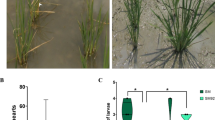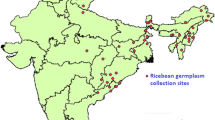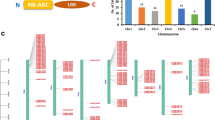Abstract
Orobanche spp. (broomrape) is an obligate root parasite that can attack a wide spectrum of plants, including tobacco. It has been responsible for economic losses in Europe since 2002 and its incidence in many tobacco-growing countries is increasing. Preventive and curative methods exist, including the use of agrochemicals, however efficacy is limited and pest dissemination remains important due to a high rate of multiplication of the parasite and very small long lasting seeds. The tobacco variety ‘Wika’ induces lower or delayed germination of Orobanche seeds. This seems to be conditioned by a single recessive gene (Cailleteau et al. in: CORESTA Congress, Paris, 2006). Artificial testing in Petri dishes was developed to evaluate the ability of tobacco plantlets to stimulate seed germination. Different lines derived from ‘Wika’, with susceptible control lines, were tested and studied by RNA-Seq. Candidate markers including SNPs or genes differentially expressed between susceptible and resistant lines were identified. An F2 population segregating for ‘Wika’ recessive tolerance was then used for marker validation and mapping. All candidates were situated on chromosome 14 of the tobacco genetic map. The Nicotiana variety collection from Imperial Brands was also tested for these markers, highlighting or confirming other potential tolerant lines. KASP™ genotyping or markers for conventional gel electrophoresis are now available to drive the transfer of ‘Wika’ recessive tolerance into elite lines. RNA-Seq technology combined with sound experimental testing has again proven its high efficiency to identify useful markers for tobacco breeding.



Similar content being viewed by others
References
Abbes Z, Kharrat M, Pouvreau JB, Delavault P, Chaibi W, Simier P (2010) The dynamics of faba bean (Vicia faba L.) parasitism by Orobanche foetida. Phytopathol Mediterr 49:239–248
Aly R (2007) Conventional and biotechnological approaches for control of parasitic weeds. Vitro Cell Dev Biol Plant 43:304–318
Bardaro N, Marcotrigiano AR, Bracuto V et al (2016) Genetic analysis of resistance to Orobanche crenata (Forsk.) in a pea (Pisum sativum L.) low-strigolactone line. J Plant Pathol 98:671–675
Barker ER, Press MC, Scholes JD, Quick WP (1996) Interactions between the parasitic angiosperm Orobanche aegyptiaca and its tomato host: growth and biomass allocation. New Phytol 133:637–642
Bindler G, Plieske J, Bakaher N, Gunduz I, Ivanov N, Van der Hoeven R, Ganal M, Donini P (2011) A high density genetic map of tobacco (Nicotiana tabacum L.) obtained from large scale microsatellite marker development. Theor Appl Genet 123:219–230
Booker J, Sieberer T, Wright W, Williamson L, Willett B, Stirnberg P et al (2005) MAX1 encodes a cytochrome P450 family member that acts downstream of MAX3/4 to produce a carotenoid-derived branch-inhibiting hormone. Dev Cell 8:443–449
Brault M, Betsou F, Jeune B, Tuquet C, Sallé G (2007) Variability of Orobanche ramosa populations in France as revealed by cross infestations and molecular markers. Environ Exp Bot. https://doi.org/10.1016/j.envexpbot.2007.06.009
Brault-Hernandez (2006) L’orobanche rameuse en France, Le couple Orobanche ramosa L./Nicotiana tabacum L.: biologie, spécificité et méthodes de lutte. Doctoral Thesis. Univ. Pierre et Marie Curie (Paris VI)
Brun G, Braem L, Thoiron S, Gevaert K, Goormachtig S, Delavault P (2017) Seed germination in parasitic plants: what insights can we expect from strigolactone research? J Exp Bot. https://doi.org/10.1093/jxb/erx472
Buschmann H, Gonsior G, Sauerborn J (2005) Pathogenicity of branched broomrape (Orobanche ramosa) populations on tobacco cultivars. Plant Pathol. https://doi.org/10.1111/j.1365-3059.2005.01211.x
Cailleteau B, Mornet F, Verrrier JL (2006) A genetically determined trait in flue-cured tobacco results in low germination of Orobanch ramose L. seed. In: CORESTA Congress, Paris, 2006 (Oral presentation)
Cardoso C, Ruyter-Spira C (2005) Strigolactones and root infestation by plant-parasitic Striga, Orobanche and Phelipanche spp. Plant Sci. https://doi.org/10.1016/j.plantsci.2010.11.007
Ćavar S, Zwanenburg B, Tarkowski P (2015) Strigolactones: occurrence, structure, and biological activity in the rhizosphere. Phytochem Rev 14:691–711
Covarelli L (2002) Studies on the control of broomrape (Orobanche ramosa L.) in virginia tobacco (Nicotiana tabacum L.). Contrib Tob Res. https://doi.org/10.2478/cttr-2013-0733
Darvishzadeh R (2016) Genetic variability, structure analysis, and association mapping of resistance to broomrape (Orobanche aegyptiaca Pers.) in tobacco. J Agric Sci Technol 18:1407–1418
Díaz-Ruiz R, Torres AM, Satovic Z, Gutierrez MV, Cubero JI, Román B (2010) Validation of QTLs for Orobanche crenata resistance in faba bean (Vicia faba L.) across environments and generations. Theor Appl Genet 120:909–919
Dor E, Alperin B, Wininger S, Ben-Dor B, Somvanshi VS, Koltai H et al (2009) Characterization of a novel tomato mutant resistant to the weedy parasites Orobanche and Phelipanche spp. Euphytica. https://doi.org/10.1007/s10681-009-0041-2
Dor E, Yoneyama K, Wininger S, Kapulnik Y, Yoneyama K, Koltai H et al (2011) Genetics and resistance strigolactone deficiency confers resistance in tomato line SL-ORT1 to the parasitic weeds Phelipanche and Orobanche spp. Phytopathology 101:213–222
Edwards KD, Fernandez-Pozo N, Drake-Stowe K, Humphry M, Evans AD et al (2017) A reference genome for Nicotiana tabacum enables map-based cloning of homeologous loci implicated in nitrogen utilization efficiency. BMC Genom. https://doi.org/10.1186/s12864-017-3791-6
Eizenberg H, Hershenhorn D, Eizenberg J, Plakhine Y, Rubin B (2003) Resistance to broomrape (Orobanche spp.) in sunflower (Helianthus annuus L.) is temperature dependent. J Exp Bot 54(395):1305–1311
Fernández-Aparicio M, Westwood JH, Rubiales D (2011) Agronomic, breeding, and biotechnological approaches to parasitic plant management through manipulation of germination stimulant levels in agricultural soils. Botany 89(12):813–826
Fernández-Aparicio M, Kisugi T, Xie X, Rubiales D, Yoneyama K (2014) Low strigolactone root exudation: a novel mechanism of broomrape (Orobanche and Phelipanche spp.) resistance available for faba bean breeding. J Agric Food Chem 62:7063–7071
Fernández-Aparicio M, Reboud X, Gibot-Leclerc S (2016) Broomrape weeds. Underground mechanisms of parasitism and associated strategies for their control: a review. Front Plant Sci. https://doi.org/10.3389/fpls.2016.00135
Gibot-Leclerc S, Brault M, Pinochet X, Sallé G (2003) Potential role of winter rape weeds in the extension of broomrape in Poitou-Charentes. C R Biol 326(7):645–658
Habimana S, Nduwumuremyi A, Chinama RJD (2014) Management of Orobanche in field crops: a review. J Soil Sci Plant Nutr. https://doi.org/10.4067/S0718-95162014005000004
Joel DM, Hershenhorn J, Eizenberg H, Aly R, Ejeta G, Rich PJ et al (2007) Biology and management of weedy root parasites. In: Janick J (ed) Horticultural reviews. Wiley, Hoboken. https://doi.org/10.1002/9780470168011.ch4
Julio E, Cotucheau J, Volpatti C, Decorps R, Sentenac C, Candresse T, Dorlhac de borne F (2015) A eukaryotic translation initiation factor 4E (eIF4E) is responsible for the “va” tobacco recessive resistance to potyviruses. Plant Mol Biol Rep 1:1. https://doi.org/10.1007/s11105-014-0775-4
Koltai H, LekKala SP, Bhattacharya C, Mayzlish-Gati E, Resnick N, Wininger S et al (2010) A tomato strigolactone-impaired mutant displays aberrant shoot morphology and plant interactions. J Exp Bot 61(6):1739–1749
Labrousse P, Arnaud MC, Serieys H, Bervillé A, Thalouarn P (2001) Several mechanisms are involved in resistance of Helianthus to Orobanche cumana Wallr. Ann Bot 88:859–868
Leitch IJ, Hanson L, Lim KY, Kovarik A, Chase MW, Clarkson JJ et al (2008) The Ups and downs of genome size evolution in polyploid species of nicotiana (solanaceae). Ann Bot 101:805–814
Letousey P, De Zélicourt A, Vieira Dos Santos C, Thoiron S, Monteau F, Simier P et al (2007) Molecular analysis of resistance mechanisms to Orobanche cumana in sunflower. Plant Pathol. https://doi.org/10.1111/j.1365-3059.2007.01575.x
Lim KY, Matyasek M, Kovarik A, Leitch AR (2004) Genome evolution in allotetraploid Nicotiana. Reports of the International Polyploidy Conference, London, UK, 27–30 April 2003
Lins RD, Colquhoun JB, Mallory-Smith CA (2007) Effect of small broomrape (Orobanche minor) on red clover growth and dry matter partitioning. Weed Sci 55:517–520
Manschadi AM, Kroschel J, Sauerborn J (1996) Dry matter production and partitioning in the host-parasite-association Vicia faba Orobanche crenata. J Appl Bot 70:224–229
Manschadi AM, Sauerborn J, Stutzel H (2001) Quantitative aspects of Orobanche crenata infestation in faba beans as affected by abiotic factors and parasite soil seedbank. Weed Res 41:311–324
Ocaña-Moral S, Gutiérrez N, Torres AM, Madrid E (2017) Saturation mapping of regions determining resistance to Ascochyta blight and broomrape in faba bean using transcriptome-based SNP genotyping. Theor Appl Genet 130:2271–2282
Parker C (1994) The present state of the Orobanche problem. Biology and management of Orobanche. In: Proceedings of the third international workshop on Orobanche and related Striga research, Amsterdam, Netherlands, 8–12 November 1993, pp 17–26. Royal Tropical Institute, Amsterdam, Netherlands
Parker C (2009) Observations on the current status of Orobanche and striga problems worldwide. Pest Manag Sci 65:453–459
Parker C, Riches CR (1993) Parasitic weeds of the world: biology and control. CAB International, Wallingford, UK
Pavan S, Schiavulli A, Marcotrigiano AR, Bardaro N, Bracuto V et al (2016) Characterization of low-strigolactone germplasm in Pea (Pisum sativum L.) resistant to Crenate Broomrape (Orobanche crenata Forsk.). Mol Plant Microbe Interact 29:743–749
Pérez-de-Luque A, Jorrín J, Cubero JI, Rubiales D (2005a) Orobanche crenata resistance and avoidance in pea (Pisum spp.) operate at different developmental stages of the parasite. Weed Res 45:379–387
Pérez-de-Luque A, Rubiales D, Cubero JI, Press MC, Scholes J et al (2005b) Interaction between Orobanche crenata and its host legumes: unsuccessful haustorial penetration and necrosis of the developing parasite. Ann Bot 95:935–942
Renny-Byfield S, Chester M, Kovarik A, Le Comber SC, Grandbastien MA et al (2011) Next generation Sequencing reveals genome downsizing in allotetraploid Nicotiana tabacum, predominantly through the elimination of paternally derived repetitive DNAs. Mol Biol Evol 28:2843–2854
Rispail N, Dita MA, González-Verdejo C, Pérez-De-Luque A, Castillejo MA, Prats E et al (2007) Plant resistance to parasitic plants: molecular approaches to an old foe: Research review. New Phytol. https://doi.org/10.1111/j.1469-8137.2007.01980.x
Rubiales D (2003) Parasitic plants, wild relatives and the nature of resistance. New Phytol 160:459–461
Rubiales D (2014) Legume breeding for broomrape resistance. Czech J Genet Plant Breed 50:144–150
Rubiales D (2018) Can we breed for durable resistance to broomrapes? Phytopathol Mediterr 57(1):170–185. https://doi.org/10.14601/Phytopathol_Mediterr-22543
Rubiales D, Rojas-Molina MM, Sillero JC (2016) Characterization of resistance mechanisms in Faba Bean (Vicia faba) against Broomrape Species (Orobanche and Phelipanche spp.). Front Plant Sci 7:1747. https://doi.org/10.3389/fpls.2016.01747
Samejima H, Sugimoto Y (2018) Recent research progress in combatting root parasitic weeds. Biotechnol Biotechnol Equip. https://doi.org/10.1080/13102818.2017.1420427
Sierro N, Battey JND, Ouadi S, Bakaher N, Bovet L, Willig A et al (2014) The tobacco genome sequence and its comparison with those of tomato and potato. Nat Commun 5:3833
Strickler SR, Bombarely A, Mueller LA (2012) Designing a transcriptome next-generation sequencing project for a nonmodel plant species. Rev Am J Bot 99:257–266
Tong Z, Xiao B, Jiao F, Fang D, Zeng J, Wu X, Chen X, Yang J, Li Y (2016) Large-scale development of SSR markers in tobacco and construction of a linkage map in flue-cured tobacco. Breed Sci 66:381–390
Torres-Vera R, Garcıa JM, Pozo MJ et al (2016) Expression of molecular markers associated to defense signalling pathways and strigolactone biosynthesis during the early interaction tomato-Phelipanche ramosa. Physiol Mol Plant Pathol 94:100–107
Trabelsi I, Abbes Z, Amri M, Kharrat M (2016) Study of some resistance mechanisms to Orobanche spp. infestation in faba bean (Vicia faba L.) breeding lines in Tunisia. Plant Prod Sci 19:562–573
Trabelsi I, Yoneyama K, Abbes Z, Amri M, Xie X, Kisugi T et al (2017) Characterization of strigolactones produced by Orobanche foetida and Orobanche crenata resistant faba bean (Vicia faba L.) genotypes and effects of phosphorous, nitrogen, and potassium deficiencies on strigolactone production. South Afr J Bot 108:15–22
Umehara M, Hanada A, Yoshida S, Akiyama K, Arite T, Takeda-Kamiya N et al (2008) Inhibition of shoot branching by new terpenoid plant hormones. Nature 455:195–200
Van Ooijen J (2006) JoinMap 4. Software for the calculation of genetic linkage maps in experimental populations. Kyazma BV, Wageningen
Vogel JT, Walter MH, Giavalisco P, Lytovchenko A, Kohlen W, Charnikhova T et al (2010) SlCCD7 controls strigolactone biosynthesis, shoot branching and mycorrhiza-induced apocarotenoid formation in tomato. Plant J 61:300–311
Waters MT, Gutjahr C, Bennett T, Nelson DC (2017) Strigolactone signaling and evolution. Annu Rev Plant Biol 68:291–322
Westwood JH (2000) Characterization of the Orobanche-Arabidopsis system for studying parasite-host interactions. Weed Sci 48:742–748
Xie X, Yoneyama K, Yoneyama K (2010) The strigolactone story. Annu Rev Phytopathol 48:93–117. https://doi.org/10.1146/annurev-phyto-073009-114453
Yang C, Xu L, Zhang N, Islam F, Song W et al (2017) iTRAQ-based proteomics of sunflower cultivars differing in resistance to parasitic weed Orobanche cumana. Proteomics. https://doi.org/10.1002/pmic.201700009
Yoder JI, Scholes JD (2010) Host plant resistance to parasitic weeds; recent progress and bottlenecks. Curr Opin Plant Biol. https://doi.org/10.1016/j.pbi.2010.04.011
Yoshida S, Shirasu K (2012) Plants that attack plants: molecular elucidation of plant parasitism. Curr Opin Plant Biol. https://doi.org/10.1016/j.pbi.2012.07.004
Yoshida S, Cui S, Ichihashi Y, Shirasu K (2016) The haustorium, a specialized invasive organ in parasitic plants. Annu Rev Plant Biol 67:643–667. https://doi.org/10.1146/annurev-arplant-043015-111702
Author information
Authors and Affiliations
Corresponding author
Additional information
Publisher's Note
Springer Nature remains neutral with regard to jurisdictional claims in published maps and institutional affiliations.
Electronic supplementary material
Below is the link to the electronic supplementary material.
Rights and permissions
About this article
Cite this article
Julio, E., Malpica, A., Cotucheau, J. et al. RNA-Seq analysis of Orobanche resistance in Nicotiana tabacum: development of molecular markers for breeding recessive tolerance from ‘Wika’ tobacco variety. Euphytica 216, 6 (2020). https://doi.org/10.1007/s10681-019-2544-9
Received:
Accepted:
Published:
DOI: https://doi.org/10.1007/s10681-019-2544-9




